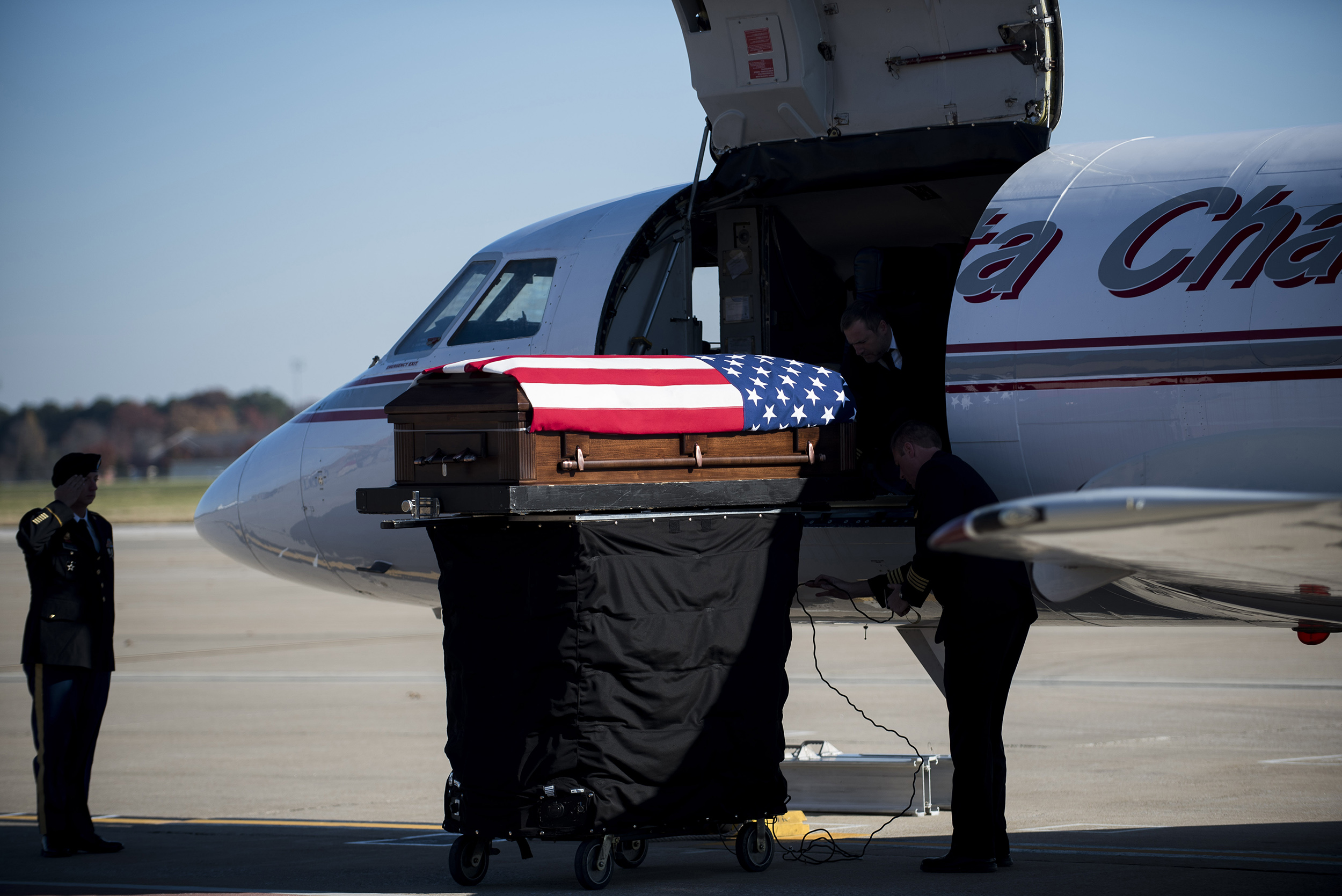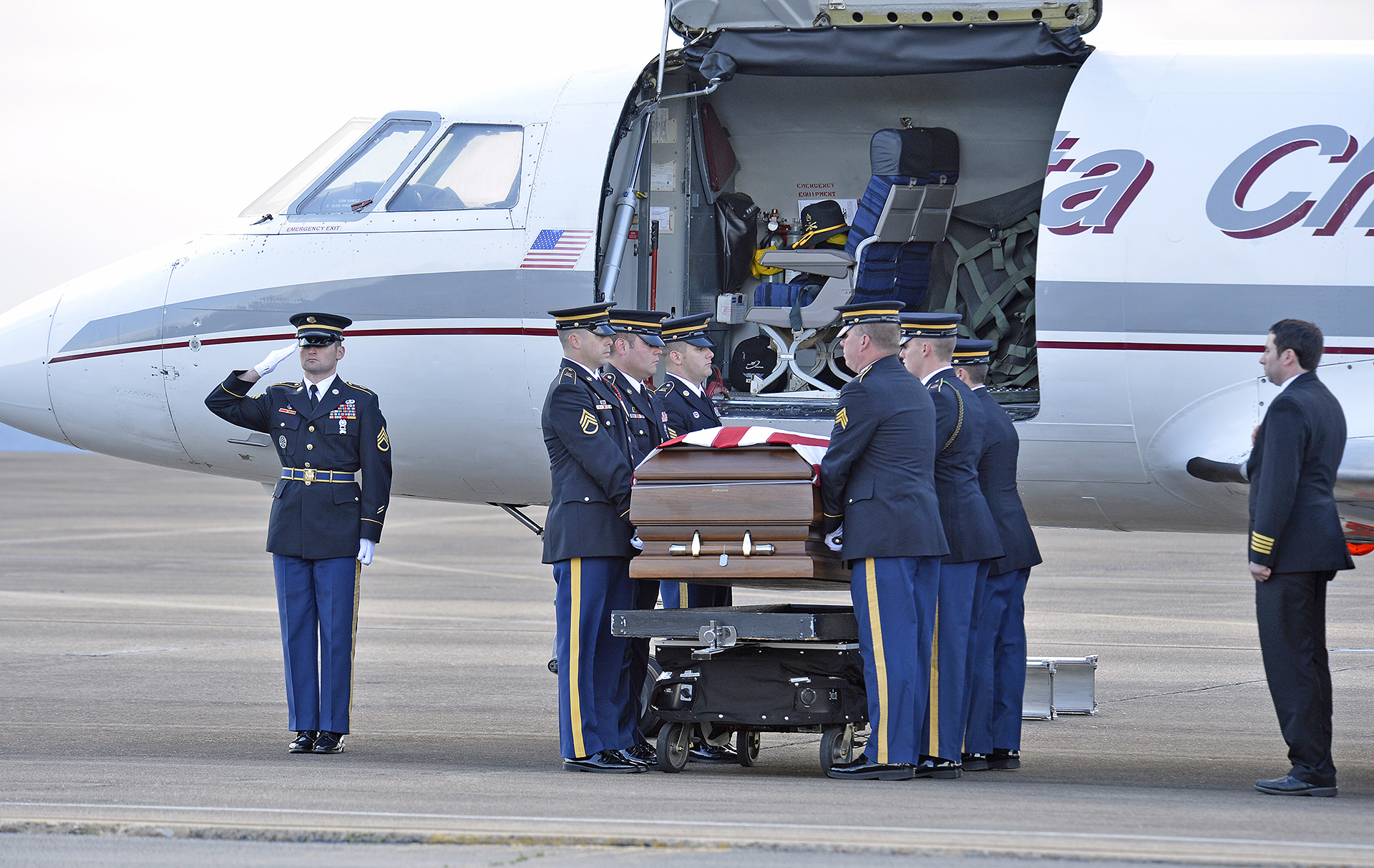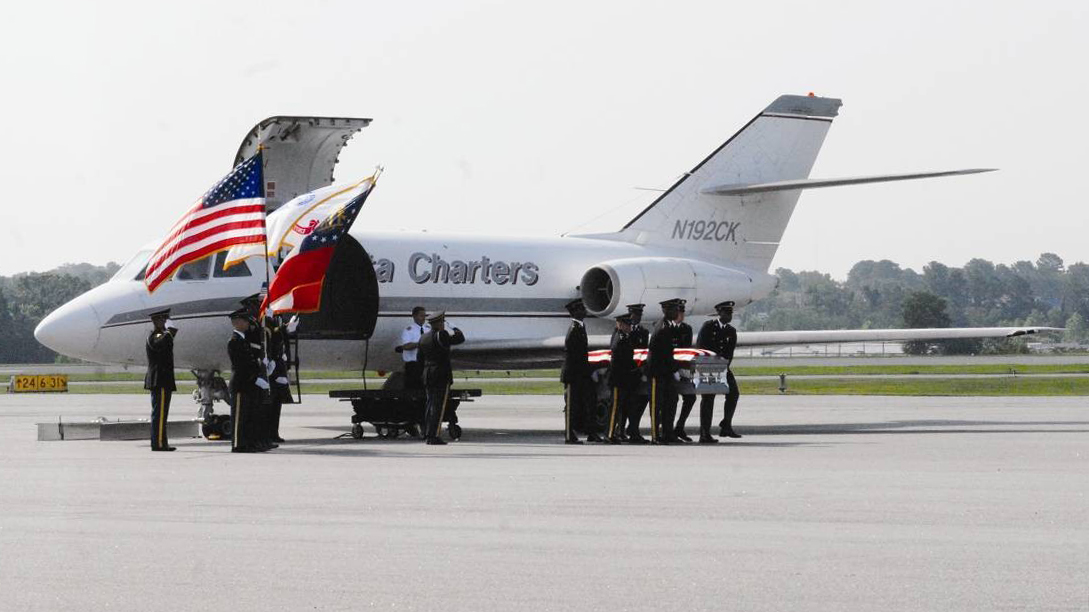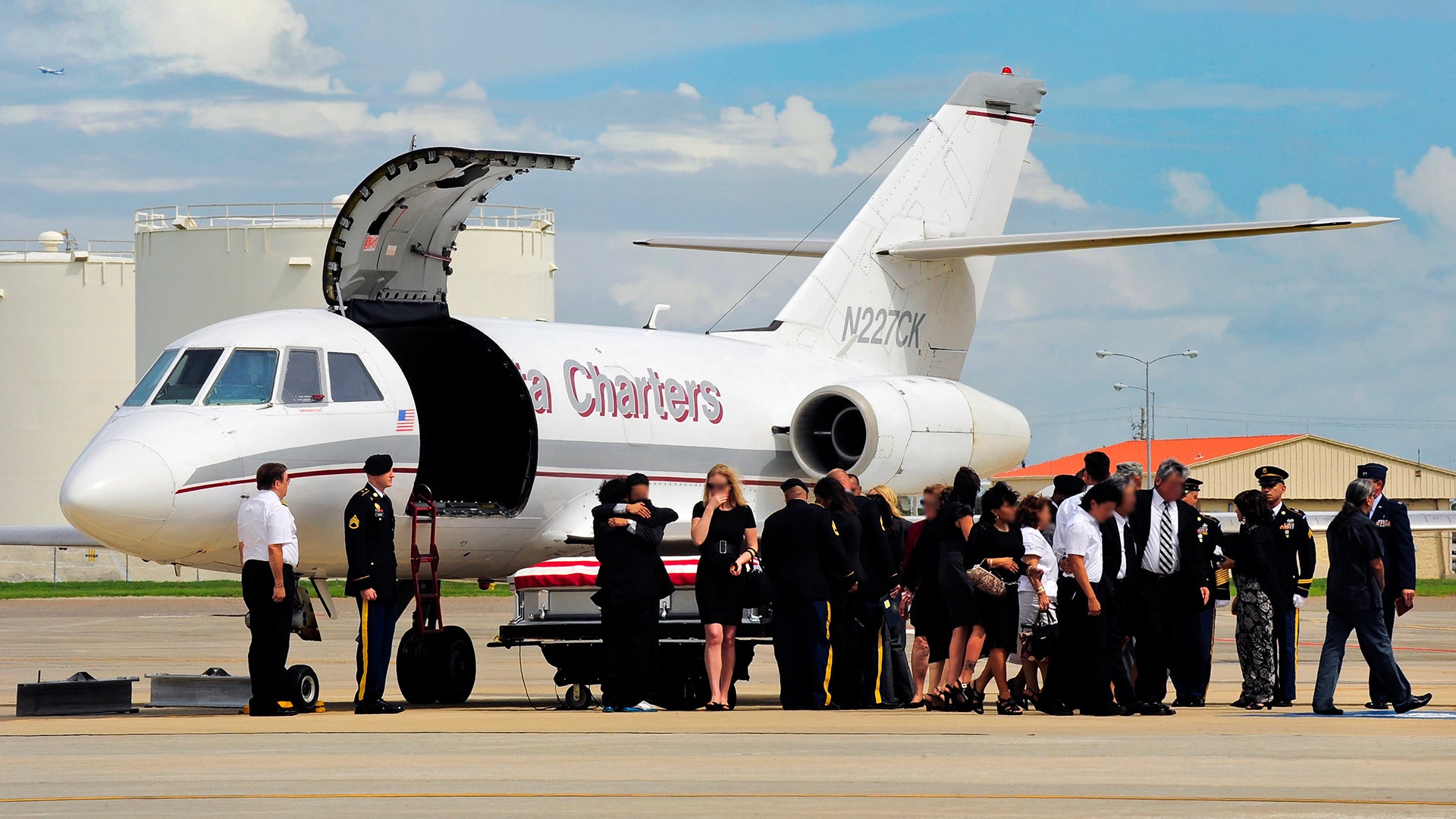For airplane spotters, it’s always exciting to see a rare plane in a special paint job appear at your hometown airport. But for one cadre of very special aircraft, their arrival comes with a far more solemn realization. The aircraft I am referring to are a handful of modified Falcon 20 business jets operated by a prolific family-owned charter and aviation services company located on Willow Run Airport, in Ypsilanti, Michigan—Kalitta Charters. Over the last decade and a half, these aircraft and their dedicated flight crews have been exclusively tasked with one of the most challenging but critical aviation missions in the country — one that comes with an immense emotional toll — the dignified transfer of America’s fallen heroes.
After 20 years of perpetual war abroad, Americans have become all-too-accustomed to seeing images of flag-draped coffins being offloaded from military transport aircraft at Dover Air Force Base. But what most don’t see is what comes next — how the remains of those service people actually make it to their families and friends, who await their return in emotionally shattered states in small towns and cities scattered around the country. That is where Kalitta’s dedicated crews and their decades-old Falcon jets come in to play.

I reached out to Kalitta to see if the company would be willing to give us a firsthand perspective of these extremely challenging operations, including background on the aircraft that supports it and on how the crews have been able to cope doing it for all these years.
Berry Birurakis, the General Manager of Kalitta Charters, was kind enough to answer our request. Birurakis noted in our correspondence that he “personally flew some of these missions and they were, psychologically, the most difficult missions I ever flew.” He also brought in Steve Green, who had managed the Dignified Transfer mission for the company since its inception up until recently retiring, to best answer all our questions.
Here is our exchange:
When did Kalitta get involved with this mission? How did it happen?
The RFP for the mission was issued in October 2006. The start date for the bridge contract was January 1, 2007. Kalitta had a very short window to retrofit five Falcon 20s (four deployed and one spare) and to design and build five MHE (Materiel Handling Equipment) units.
In mid-November 2006, Kalitta was awarded the initial bridge contract to commence on January 1, 2007, and continue through July 2007. In an unprecedented move, Kalitta Maintenance began working around the clock, seven days per week, up until the morning of December 31, 2006. On that morning, all four Falcons departed YIP (Ypsilanti, MI) and flew to Dover AFB in Delaware to stage. The next day, January 1, 2007 (day one of the mission), all four aircraft left Dover on “Dignified Transfer” missions.

Why are private charter aircraft used for the Dignified Transfer mission?
Prior to using the Falcons, most caskets were transported using commercial airliners flying into large commercial airports. There was a lack of MHE designed specifically for the task. Caskets were seen by veterans groups being handled with forklifts, belt loaders, and baggage carts in what was considered an undignified manner. DoD then issued an RFP (Request For Proposal) to the air charter community to find a more dignified way of transporting our fallen heroes. Kalitta Charters has decades of experience in retrofitting aircraft and MHE for specific mission requirements and accepted the challenge of complying with all mission requirements. The Falcon was obviously the right aircraft, and Kalitta’s engineering group developed MHE that could be carried aboard the aircraft.
The Falcon 20 requires less runway for takeoff and landing than commercial airliners which opened up hundreds of additional destination airports. In many cases, the Falcon was able to land at the hometown airport of a fallen hero versus landing at a large commercial airport that could be over 100 miles away.
Although the cost of operating the Falcon is higher than that of using commercial aircraft, it is thousands less per mission than any U.S. Air Force platform. The advantages of getting into small airports, carrying mission-specific MHE aboard the aircraft, and crews trained in conducting “Reverse Dignified Transfers” at the destination airport are but a few factors in using charter aircraft.

Kalitta Charters always had backup aircraft on standby. On extremely rare occasions, the backup aircraft was flown immediately to continue the mission if a maintenance issue grounded the primary aircraft. This was not the case with commercial airliners, who would cancel a flight with no other means of continuing the mission. In those cases, the commercial airliners would simply state that the flight was canceled, and they would deliver the casket the next day. That scenario was totally unacceptable, when the family and typically a large contingent of sympathizers were gathering at the destination airport. When such cancellations occurred, the DoD would dispatch a Kalitta Falcon to continue the mission.
There are myriad other advantages to using the Falcons, but these are the primary ones that come to mind.
What was needed in terms of hardware and personnel to support the mission?
The Falcon 20 is used because it is the ideal size to transport up to 2 caskets at a time and all of the equipment necessary for the Dignified Transfer and Reverse Dignified Transfer of the fallen heroes. The actual aircraft were already freight-configured and needed no real modifications to fly the missions. All we really had to do was design the system to allow for loading and unloading the fallen heroes in a dignified manner.
Some of the aircraft are former FedEx aircraft. Others started life as passenger aircraft that were later modified to transport cargo. The cargo transportation modification consisted of removing all of the interior behind the cockpit, reinforcing the floor, placing a protective liner on the walls and ceiling, removing the passenger door, and cutting a large part of the left side forward cabin wall out and putting a cargo door there.

These are older airplanes. We have an awesome team of maintenance specialists that do a great job of keeping these planes going. Very rarely do we experience a delay for mechanical reasons and, to date, we have never had a mission failure for any reason.
How many Dignified Transfer missions has Kalitta flown?
We have flown more than 2,600 of these missions. Some of these missions actually carried two fallen heroes.
Can you give us an idea of how one of these operations is executed?
Our dispatch gets a call from the Dover AFB Mortuary Affairs Office when a fallen hero is to be transported. We are advised of where the family would like the fallen hero to end up and the date and time they want the plane to arrive. Our dispatch finds the nearest suitable airport and plans the departure from Dover to allow for the arrival at the desired time.
On the day of the flight, the airplane is prepared, and the Dignified Transfer ceremony is performed to load the casket into the airplane. The fallen hero is always accompanied by an escort, usually from the fallen hero’s unit. There are only two seats in the back of the plane. If we are only moving one fallen hero we can (and have) moved a family member.
The honor guard coordination is all done by the DoD. The honor guard at Dover is well-versed in the Dignified Transfer process. When we first put this program together we set up a “simulated” mission that the DoD filmed. We were told that the honor guard at the drop-off location is given access to the video to allow them to prep for the arrival and the Reverse Dignified Transfer.
The airplane departs a little early to allow for the possibility of unforecast winds and/or air traffic control delays. As the plane nears its destination, the crew adjusts its speed to allow them to arrive as close to the scheduled time as possible.
Once the plane lands, the crew prepares for and conducts the Reverse Dignified Transfer ceremony.
The human toll has to be an issue. How have Kalitta aircrews been impacted by such a solemn but honorable mission?
Interesting question. As the project manager for the mission, I thought we had considered every possible contingency that might affect our performance to a “zero-fail” standard. As NASA likes to say, “failure is not an option.”
On day one, I watched the Dignified Transfers on the ramp at Dover. I watched all four aircraft depart within minutes of each other for various destinations and my own emotions were inevitable. It was then that I became acutely aware of what the crews were going to face at the destination airport. That awareness was confirmed hours later when the first Falcon arrived back at Dover.

The Captain of that Falcon was our chief pilot, Bob Newell. Bob climbed down the ladder and began the post-flight inspection of his aircraft. When he finished, I asked how things went at the destination. Without making eye contact, Bob’s exact words were: “Do we have to talk about this right now?”
I was there for the return of the other three aircraft, but I did not ask that question of the crews. Their silence told me all I needed to know.
Early the next morning, I went to the Charles Carson Mortuary on the base to speak to the Chaplain, Major Sparks. I told him that we all—flight crews, maintenance crews, and myself—had encountered emotions on the previous day that were unanticipated and difficult to deal with. Chaplain Sparks understood perfectly. It was his job and that of a clinical psychologist to assist USAF and civilian personnel who were new to mortuary affairs at the base. He advised that there were many personnel who asked to transfer out after one day because of the emotional trauma they had experienced.
As we did not have any flights going out that second day, he asked me to have all Kalitta personnel report an anteroom at the mortuary at 1:00 PM. At that time, eight pilots, two maintenance personnel, and myself were introduced to Major Sparks and the psychologist. They took us through the introduction to Mortuary Affairs the same as if we were newly assigned USAF personnel. We spent about two hours with those guys and we all came away with a better understanding of what we had gotten ourselves into.
What I took away from that meeting was that everyone deals with it differently … but deal with it you must, because you will face it again tomorrow. Kalitta was fortunate to have several former military and National Guardsmen on staff in both the flight and maintenance departments to assist our civilian personnel in understanding the thought processes involving the mission.
The company realizes that this is the most important mission that has ever been undertaken at Kalitta Charters and has proudly carried it out to a “zero-fail” standard from January 1st, 2007, to today.
Where does the mission stand now that both wars have concluded, at least officially?
The contract started out with four airplanes being based at Dover AFB. Now that things have wound down we only have one airplane actually based at Dover and another on standby at our home base in Ypsilanti, Michigan, in case there is a need for two aircraft on the same day.

Author’s note: A huge thanks to Berry Birurakis and Steve Green for making this story happen, as well as to all those who have been involved in this critical mission over the years.
Contact the author: Tyler@thedrive.com
